#nc science center
Text
Got to go to the NC Museum of Natural Sciences (official name lol it's the NC science center) today!! Haven't been in a hot minute and haven't been with my dad in years! Fun was had!

Zoom in on this one, there's some really neat stuff
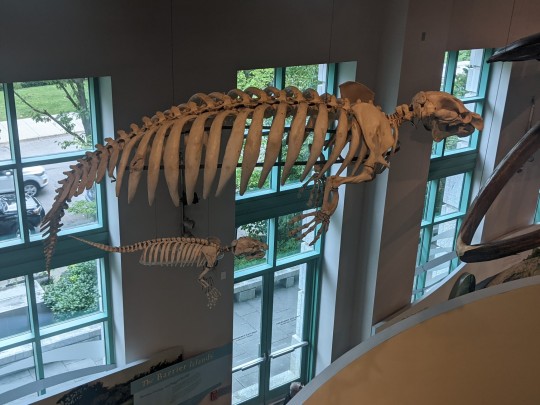
🎶 Barbra manatee (manatee), you have a small ba-by (small ba-by)🎶
Blue whale bones! I wish you could get good scale for these, each of those tail bones is bigger than I am
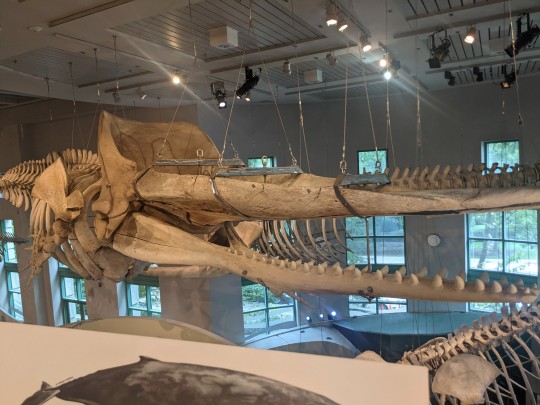
Somehow, when you think of Moby Dick, you never imagine something this big (those are normal sized spotlights, and the sign you can see at the bottom is probably only 2 feet long lol)
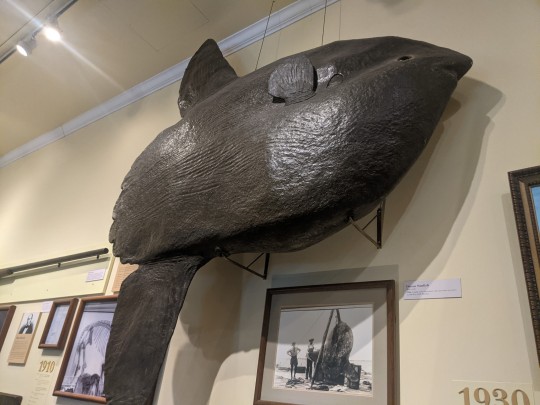
Mola mola! (I didn't know you could catch these off the NC coast lol)

A very lazy snapping turtle

Gar!

I best not hear anyone disrespect my mnts ever again
"... believe mnt lions may now be extinct in NC" distribution map: no

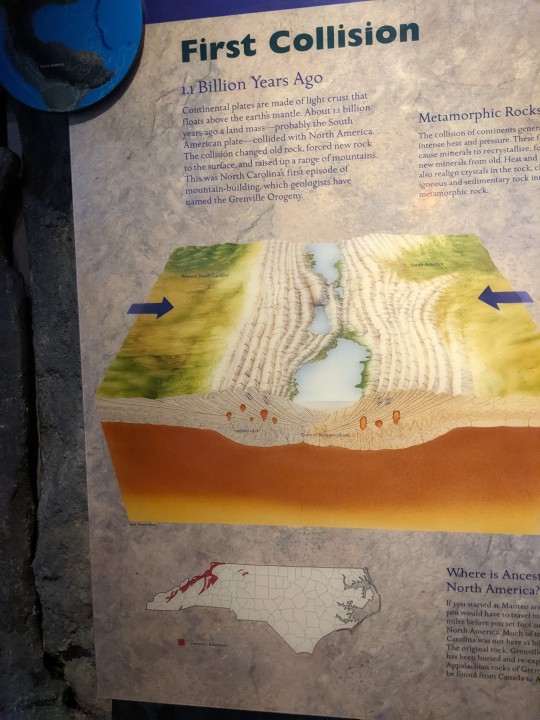
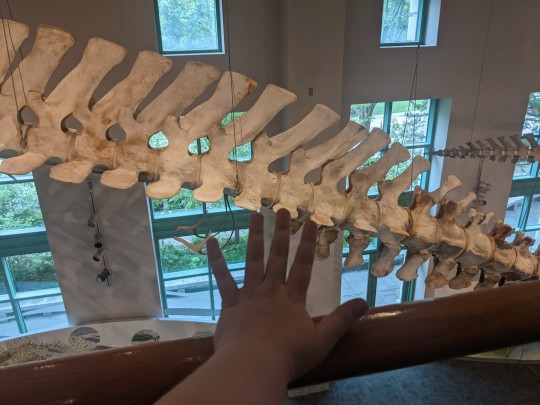
Oh worm?
More in the reblog!!
#museum#science center#nc science center#north carolina#bugs#whales#bones#snapping turtle#gar#mola mola#sunfish
24 notes
·
View notes
Text
Interesting proposal by Nate Loewentheil in a guest column in The New York Times. Not only was his proposal thought provoking, but two of the comments regarding it by readers were also worth contemplating. Below are some excerpts from the column, followed by the two comments.
Here is a proposal for the environmental movement: Pool philanthropic funds for a day, buy a small plot of land in Washington, D.C., and put up a tall marble wall to serve as a climate memorial. Carve on this memorial the names of public figures actively denying the existence of climate change. Carve the names so deep and large, our grandchildren and great-grandchildren need not search the archives.
This is not a metaphor. The problem with climate change is the disconnect between action and impact. If politicians vote against construction standards and a school collapses, the next election will be their last. But with climate change, cause and effect are at a vast distance.
We are already seeing the consequences of our past and present greenhouse gas emissions. In coming decades, those emissions will wreak their full havoc on the climate, and it will take hundreds, possibly thousands, of years for those pollutants to fully dissipate. But in the short term, the most immediate burdens are borne mostly by the poor in America and distant people in distant lands. Misaligned incentives are at the heart of why some political and business leaders deny and delay.
[...]
I would first nominate those who have sown confusion over climate science, like Myron Ebell, who recently retired as director of the Competitive Enterprise Institute’s Center for Energy and Environment, where he sought to block climate change efforts in Congress, and served as the head of Donald Trump’s transition team for the Environmental Protection Agency. Mr. Ebell has argued that the idea that climate change is “an existential threat or even crisis is preposterous.”
Then there are lawmakers who have consistently stood in the way of federal action, like the recently retired senator James Inhofe of Oklahoma, the author of the book “The Greatest Hoax: How the Global Warming Conspiracy Threatens Your Future.”
[color emphasis added]
Below is the first thought provoking comment to this article:
There is, in Iceland, a memorial to a dead glacier - the Ok Glacier. It reads: "Ok is the first Icelandic glacier to lose its status as a glacier. In the next 200 years all our glaciers are expected to follow the same path. This monument is to acknowledge that we know what is happening and what needs to be done. Only you know if we did it." [color emphasis added]
--Chris D., Colorado

Photo of the plaque at the at the Okjökull (OK Glacier) memorial.
Here is the second thought provoking comment to this article:
For reference this graph https://i.redd.it/ljifc828iui31.jpg is from the Exxon internal scientific report on climate change, 1982, produced by scientists working for that fossil fuel corporation.
Look at what their graph predicted for 2020.
Approaching 420 ppm CO2 and a rise of 1.2 C degrees above pre-industrial temperature - very close to what we actually got in 2020.
Then look at what the graph shows for later this century, based on not reducing emissions.
Very serious temperature rises, that could make agriculture very difficult in many countries.
Yes, and then Exxon, having seen this, got involved in PR campaigns to "cast doubt" on climate science, to protect their assets. [color emphasis added]
--Erik Frederiksen, Ashville, NC

1982 Exxon graph depicting average global temperature increases over time correlating with increases in atmospheric CO2. NOTE: Graph color was modified for greater clarity.
Fossil fuel companies like Exxon, and fossil fuel oligarchs like the Koch brothers should be included in any "Climate Wall of Shame."
#climate change#disinformation about climate change#climate change deniers#climate wall of shame#myron ebell#james inhofe#koch brothers#exxon#fossil fuel industry#ok glacier memorial#nate loewentheil#the new york times
69 notes
·
View notes
Text

Helping Heal Bone
A 3D-printed scaffold with cryogel fibres incorporating vessel growth- and bone formation-enhancing peptides for promoting bone regeneration at the site of skull damage or defect
Read the published research article here
Image from work by Yuxuan Wei and Hao Pan, and colleagues
Zhejiang Engineering Research Center for Tissue Repair Materials, Wenzhou Institute, University of Chinese Academy of Sciences, Wenzhou, Zhejiang, China
Image originally published with a Creative Commons Attribution 4.0 International (CC BY-NC 4.0)
Published in Science Advances, February 2024
You can also follow BPoD on Instagram, Twitter and Facebook
16 notes
·
View notes
Text



Female eastern diamond back terrapin enclosure at the Greensboro science center. One of my absolute favorite turtle species!


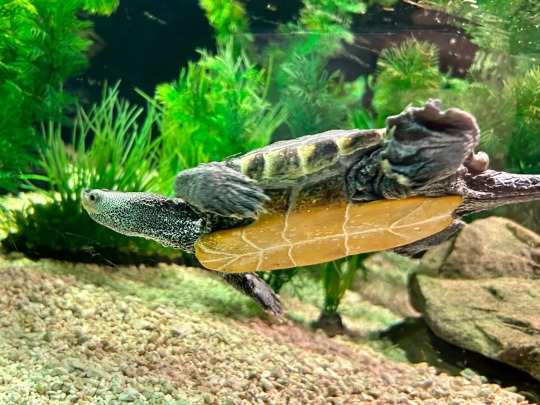
They also had a male in a smaller enclosure which I got to see basking in the morning and being super active in the afternoon! Great turtles. I dream of being able to keep a big brackish indoor pond with them and some native killies etc but they are a protected species in NC, which I am actually thankful for! Smuggling turtles for the food / traditional medicine market is unfortunately still big business in the southeast USA so any additional protections on our native turtles is welcomed.
27 notes
·
View notes
Text
The Nature of Borderline Personality Disorder’s Concerningly High Comorbidity Rate with Substance Use Disorder
Background
The research that will be conducted is in regards to borderline personality disorder and its comorbid relationship with substance use disorder. An alarming number of individuals diagnosed with borderline personality disorder also experience substance use frequent enough to present significant issue in their day-to-day functioning, which often results in a comorbid diagnosis of substance use disorder. Approximately 78% of adults with borderline personality disorder (henceforth noted as “BPD” in this proposal) develop a substance use disorder or addiction at some time in their lives, according to research conducted by the US National Comorbidity Survey Replication (NCS-R). We will take a closer look at what causes the relationship between BPD and using substances, the insurmountable grief of BPD that so commonly pervades these individuals’ lives, other contributing symptoms, and what role childhood and upbringing have in determining whether or not someone with BPD will develop substance use disorder.
Research Question
Why are individuals with BPD so prone to self-medicating with substance, and how can this be avoided or treated? What can others do to support a loved one with BPD and comorbid substance use disorder?
Subtopics To Be Investigated
The subtopics that will be discussed in this paper are as follows: emotional dysregulation, distress intolerance, impulsivity, suicidality, upbringing (particularly childhood trauma), physical health complications such as chronic pain, and the stress-induced quasi-psychotic symptoms that sometimes occur in BPD.
Summary of Preliminary Findings
The sources for this paper are as follows: National Library of Medicine: National Center for Biotechnology Information, The Canadian Journal of Psychiatry, The Clinical Journal of Pain, Wikipedia, Science Direct: Journal of Affective Disorders, and ResearchGate. The National Library of Medicine is the world’s largest biomedical library and institution of research on medical and health-related topics. The Canadian Journal of Psychiatry is a monthly peer-reviewed medical journal originally published by the Canadian Psychiatric Association. In January of 2015, it changed publishers to SAGE Journals. Covering all aspects of psychiatry, this journal aims to educate and inform. The Clinical Journal of Pain is a monthly peer-reviewed medical journal published by Lippincott Williams & Wilkins, covering research on all aspects of pain management. Wikipedia is an online encyclopedia that relies heavily on userbase submissions, cataloguing thousands upon thousands of topics. It remains heavily accurate (despite much criticism) due to the moderation system put in place to prevent article vandalism. Science Direct is a website that provides access to a large bibliographic database of scientific and medical publications of the Dutch publisher Elsevier. And finally, ResearchGate is a European social networking site for scientists and researchers to share papers, ask and answer questions, and find collaborators. I am certain that the information found in these sources will provide the basis for a detailed discussion of borderline personality disorder and the high propensity for development of comorbid substance use disorder. All sources are in the form of webpages.
Rationale for Research
The reader can hopefully gain some valuable insight into borderline personality disorder, what causes the high comorbidity rate with substance use disorder, what can be done to prevent it or treat it, and how to support a loved one who struggles with both disorders (or each disorder separately). It is my intention that the reader walk away with a new sense of understanding on this topic.
Works Cited
Kienast, Thorsten, et al. “Borderline Personality Disorder and Comorbid Addiction: Epidemiology and Treatment.” Deutsches Arzteblatt International, U.S. National Library of Medicine, 18 Apr. 2014, www.ncbi.nlm.nih.gov/pmc/articles/PMC4010862/.
Links, Paul, et al. “Borderline Personality Disorder and Substance Abuse: Consequences of Comorbidity.” The Canadian Journal of Psychiatry, SAGE Journals, Feb. 1995, journals.sagepub.com/doi/abs/10.1177/070674379504000105.
McWilliams, Lachlan & Higgins, Kristen. “Associations Between Pain Conditions and Borderline Personality Disorder Symptoms: Findings from the National Comorbidity Survey Replication.” The Clinical Journal of Pain, Lippincott Journals, June 2013, https://journals.lww.com/clinicalpain/abstract/2013/06000/associations_between_pain_conditions_and.9.aspx.
“Management of Borderline Personality Disorder.” Wikipedia, Wikimedia Foundation, 27 Oct. 2023, https://en.wikipedia.org/wiki/Management_of_borderline_personality_disorder.
Mattingley, Sophie, et al. “Distress Tolerance across Substance Use, Eating, and Borderline Personality Disorder: A Meta-Analysis.” Journal of Affective Disorders, Elsevier, 2 Jan. 2022, www.sciencedirect.com/science/article/pii/S0165032721014439.
Lubman, Dan, et al. “Managing Borderline Personality Disorder and Substance Use: An Integrated Approach” ResearchGate, PubMed, Australian Family Physician, June 2011, www.researchgate.net/publication/51203543_Managing_borderline_personality_disorder_and_substance_use_An_integrated_approach.
...Just sharing this with y'all for no reason, as it's already been graded lol. It's a topic I'm passionate about obviously. And don't roll your eyes at the inclusion of Wikipedia, because my professor said he's okay with it and even encouraged us to use it for this research paper. He even made us participate in a group discussion post on why Wikipedia is reliable. My academic writing needs improvement, but hey, at least this is a start.
2 notes
·
View notes
Text
wrote a throwaway story, because of anxiety so here it is
Tw// suicide, death, loneliness and slight family abuse
Prologue
Jordan Rose Anderson, 16, of Asheville, NC, passed away on April 17th surrounded by friends and family. She attempted an overdose the night prior and passed away in the hospital the next day.
Jordan was born on November 4, 2005 to Janet & Chris Anderson in Louisville, Kentucky. Jordan attended The School of Inquiry and Life Sciences and was passionate about psychology and music.
While in school, she was an intern for psychology at UNC Hospital and enjoyed spending time with her friends. Jordan was also extremely passionate about music and would often be found writing songs in the music center.
Jordan met her best friends Jamie & Sam at SILS and enjoyed spending time taking photos and going to concerts with them. Jennifer was also a part of both the Photography Club and R.I.S.K. Club at SILS and was passionate about mental health and the
Jordan’s memory will forever be cherished by her friends at SILS, her family, and the doctors she worked with at the hospital.
Jordan’s POV
So I’m dead, and it’s a little bit late to turn around. I took a ton of Vitamin D3. And I died. But I can still see everyone. They are all standing around me, and I’m just kinda here. My mom is upset, and mad, she is mad at me. She was never there for me, and I guess she never thought that I would actually go through with it. My dad isn’t crying, he’s just staring at me. At my lifeless body, probably in shock or something. I mean I guess it would make sense to be in shock, I never told them that I felt this way, but they also never did anything to see how I was doing.
I was smart, like 3.5 GPA kinda stuff, not amazing but decent. I was always involved in some extracurriculars but not a 3 season athlete. I had two or three really close friends, but I knew everyone at some point. I care a lot about them, and I feel bad for leaving them, but they promised me that they’ll be okay.
My mom called Jamie first, to tell him the news, his mom picked up and said they were heading over. She called Sam next, who picked up immediately just started crying and said that she was sorry for their loss and that she was on her way. Until those two showed up, it was just my parents talking to the nurses about paperwork and stuff. Then they just sat there, they couldn’t leave me, and apparently they couldn't move me yet. So I just laid there and listened to them talk to me about how it was too soon and I shouldn’t of done it because it was a sin.
Sam showed up first, and grabbed my hand, and just sobbed, more than I ever thought she would. And she apologized, for every thing that had ever upset me, from since we were 7. She apologized for “borrowing” a lipstick last year, and she apologized for not catching me when I fell on the goddamn monkey bars when we were 10. And she apologized for everything. She even apologized for causing my death, and then I wish I wasn’t dead, I wish I could hug her and say “nono, it wasn’t you, it was everything else” but I can’t, it’s too late to say that.
Jamie in, and just hugged Sam, and cried with her. And just whispered “i love you and I’m so sorry you had to leave” and I wish I could tell him that i'm still here. Except I’m not, I’m gone.
Jamie, Sam, and my parents were asked to leave so I could be relocated and moved to the funeral home.
4 notes
·
View notes
Photo


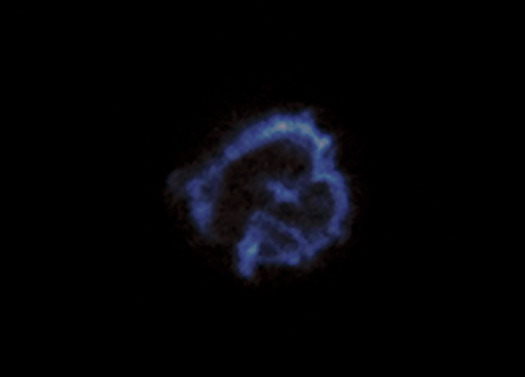


SETTING THE CLOCK ON A STELLAR EXPLOSION While astronomers have seen the debris from scores of exploded stars in the Milky Way and nearby galaxies, it is often difficult to determine the timeline of the star’s demise. By studying the spectacular remains of a supernova in a neighboring galaxy using NASA telescopes, a team of astronomers has found enough clues to help wind back the clock. The supernova remnant called SNR 0519-69.0 (SNR 0519 for short) is the debris from an explosion of a white dwarf star. After reaching a critical mass, either by pulling matter from a companion star or merging with another white dwarf, the star underwent a thermonuclear explosion and was destroyed. Scientists use this type of supernova, called a Type Ia, for a wide range of scientific studies ranging from studies of thermonuclear explosions to measuring distances to galaxies across billions of light-years. SNR 0519 is located in the Large Magellanic Cloud, a small galaxy 160,000 light-years from Earth. This composite image shows X-ray data from NASA’s Chandra X-ray Observatory and optical data from NASA’s Hubble Space Telescope. X-rays from SNR 0519 with low, medium and high energies are shown in green, blue, and purple respectively, with some of these colors overlapping to appear white. Optical data shows the perimeter of the remnant in red and stars around the remnant in white. Astronomers combined the data from Chandra and Hubble with data from NASA’s retired Spitzer Space telescope to determine how long ago the star in SNR 0519 exploded and learn about the environment the supernova occurred in. This data provides scientists a chance to “rewind” the movie of the stellar evolution that has played out since and figure out when it got started. The researchers compared Hubble images from 2010, 2011, and 2020 to measure the speeds of material in the blast wave from the explosion, which range from about 3.8 million to 5.5 million miles (9 million kilometers) per hour. If the speed was toward the upper end of those estimated speeds, the astronomers determined that light from the explosion would have reached Earth about 670 years ago, or during the Hundred Years’ War between England and France and the height of the Ming dynasty in China. However, it’s likely that the material has slowed down since the initial explosion and that the explosion happened more recently than 670 years ago. The Chandra and Spitzer data provide clues that this is the case. Astronomers found the brightest regions in X-rays of the remnant are where the slowest-moving material is located, and no X-ray emission is associated with the fastest-moving material. These results imply that some of the blast wave has crashed into dense gas around the remnant, causing it to slow down as it traveled. Astronomers may use additional observations with Hubble to determine more precisely when the time of the star’s demise should truly be set. A paper describing these results was published in the August issue of The Astrophysical Journal, and a preprint is available here. The authors of the paper are Brian Williams (NASA’s Goddard Space Flight Center (GSFC) in Greenbelt, Maryland); Parviz Ghavamian (Towson University, Maryland); Ivo Seitenzahl (University of New South Wales, Australian Defence Force Academy, Canberra); Stephen Reynolds (North Carolina State University (NCSU), Raleigh, NC); Kazimierz Borkowski (North Carolina State University, Raleigh, NC) and Robert Petre (GSFC). NASA's Marshall Space Flight Center manages the Chandra program. The Smithsonian Astrophysical Observatory's Chandra X-ray Center controls science operations from Cambridge, Massachusetts, and flight operations from Burlington, Massachusetts. IMAGES.....Composite, X-ray low, X-ray medium, X-ray high, optical.
6 notes
·
View notes
Video
youtube
Happy 67th Birthday musician Alasdair Fraser.
Alasdair was born in Clackmannan on May 14th, 1955 and began taking classical violin lessons at the age of eight, enduring much teasing and leg-pulling from fellow school pupils at a time when carrying a fiddle case around was considered far from cool. Undeterred, he persevered and found a love of and natural aptitude for the violin which he applied to the Scottish music that he heard at home – his late father, Bob, and his brother, Iain, both being musicians.
In his teens Alasdair played with dance bands and began gathering the compositions of great fiddling forebears including Niel and Nathaniel Gow, William Marshall and James Scott Skinner into a repertoire that is now vast. Twice winner of the Scottish National Fiddle Championship, he also began to notice the connection between speech patterns and musical expression, especially among Gaels and the Doric speaking players in the north-east, and incorporated this into his fiddle style.
Inclined towards science as well as music at school, Alasdair went on to work as a petrophysicist with British Petroleum, a post that took him to California in 1981 and the realisation four years later, while writing out a fiddle tune during office hours, that he was in the wrong job. He decided to concentrate on music and passing on his passion and skills through programmes such as the Valley of the Moon fiddle camp, which he founded among the Californian Redwoods in 1984 and still directs, the fiddle course that he’s run on the Isle of Skye since 1987, and the more recently established Sierra Fiddle Camp, near his home in California.
As a fiddler equally capable of playing haunting Gaelic airs and rumbustious dance tunes and improvising endless variations on traditional themes, Alasdair has worked in a variety of successful partnerships, including his duos with pianist Paul Machlis and guitarist Tony McManus and his acclaimed band Skyedance. He has also guested with The Chieftains, The Waterboys, Itzhak Perlman and Los Angeles Master Chorale, appeared on innumerable broadcasts including A Prairie Home Companion and CBS TV’s Kennedy Center Honors and performed on film soundtracks including The Last of the Mohicans and Titanic. His compositions have featured in works by the Richmond (Virginia) Ballet and Shiftworks Dance Ensemble and his commissions include Fettercairn Suite.
Since 2003 Alasdair has featured in a duo with cellist Natalie Haas, restoring the wee fiddle and big fiddle partnership that flourished in eighteenth century Scotland to contemporary prominence at the cutting edge of tradition-rooted creativity. Their debut album, Fire and Grace, was voted Album of the Year at the Scots Trad Music Awards 2004, adding to Alasdair’s North American Independent Record Distributors award for his Dawn Dance album in 1996, and they continue to thrill audiences internationally with their virtuosic playing, their near-telepathic understanding and the joyful spontaneity and sheer physical presence of their music.
Alasdair posted on his Twitter a few days ago;
“Unusual birthday celebration for me! Last of the Mohicans 30th Anniversary celebration concert in Morganton, NC Can’t wait!!”
I’ve chosen a beautiful tune by Alasdair Fraser, he plays the fiddle and orates a poem by Sorley Maclean, one of Gaeldom's great poets. Finding The Other Side Of Sorrow is from the concluding line of one of MacLean’s poems, ‘An Cuilithion, The Cuillin’ It has been described as a celebration of the awful strength of those Skye mountains, and the affinity of the Gael with such places. Some of you will have read and listened to other work by The Rasaay poet, most notably Hallaig, with the late Martyn Bennett.
Beyond the lochs of the blood of the children of men,
beyond the frailty of plain and the labour of the mountain,
beyond hardship, wrong, tyranny, distress,
beyond misery, despair, hatred, treachery,
beyond guilt and defilement; watchful,
heroic, the Cuillin is seen
rising on the other side of sorrow.
11 notes
·
View notes
Text
Les ruses de l’anémone de mer pour échapper aux prédateurs
See on Scoop.it - EntomoNews
L’anémone étoilée peut produire une toxine qui a le double intérêt de repousser une crevette carnivore et d’attirer un poisson qui s’en nourrit. Mais cette défense se fait au détriment de sa capacité de reproduction.
Par Hervé Morin
Publié le 22 mars 2024 à 06h00
------
NDÉ
L'étude
Venom trade-off shapes interspecific interactions, physiology, and reproduction | Science Advances, 13.03.2024 https://www.science.org/doi/10.1126/sciadv.adk3870
[Image] Population variation of Nv1 and its impact on defense against predators.
(A) Nematostella vectensis. (B) Map showing the location of the different populations of Nematostella across North America. Inset, maximum haploid copy number of Nv1 reported in different Nematostella populations. (C) nCounter relative RNA expression levels of Nv1 from different populations. (D) Grass shrimp (Palaemonetes pugio). Picture taken from Wikimedia by Brian Gratwicke (2006). (E) Mummichog (Fundulus heteroclitus). Picture taken from Wikimedia from the Smithsonian Environmental Research Center. (F) Average weighted score of grass shrimp proximity to Nematostella from NC and FL. (G) Average weighted score of mummichog proximity to Nematostella from NC and FL. Confidence intervals (95%) are indicated by the ends of the vertical error bars. *P < 0.05, **P < 0.01, ***P < 0.001; NS, not significant. Species silhouettes were sourced from PhyloPic. Grass shrimp (P. pugio) and Mummichog (F. heteroclitus) picture taken from Wikimedia. Nematostella photo credit: Yael Admoni.
0 notes
Text
Brazilian scientists design innovative heart valve
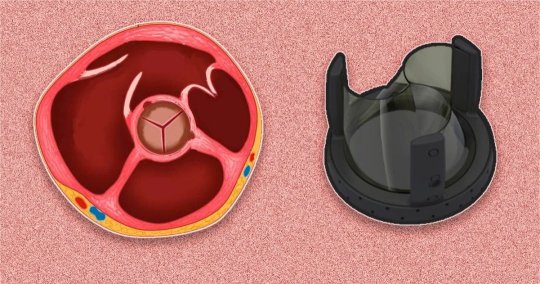
- By Agência FAPESP* -
In Brazil, researchers from the University of São Paulo (USP) and the State University of Campinas (UNICAMP) are trying to perfect the Wheatley aortic valve, a device that could improve the lives of millions of people affected by aortic stenosis, a narrowing of the aortic valve opening that blocks the flow of blood from the left ventricle to the aorta.
Aortic stenosis is common among the elderly, and in severe cases, the only viable alternative to improve the patient's quality of life is to replace the dysfunctional natural valve with an artificial one.
The studies have already won the 2023 USP Post-Doc Award in the field of exact and earth sciences for UNICAMP professor Hugo Luiz Oliveira, a member of the research group.
The improvement of the Wheatley aortic valve is important because it should eliminate the need for anticoagulant medication in the post-operative period, as is the case with other polymer valves.
Anticoagulants are used to “thin” the blood, i.e. they prevent the formation of clots and facilitate blood flow. This type of drug treatment requires extreme patient care and attention, especially when bleeding occurs which can lead to other complications.
The research, developed within the scope of the Center for Mathematical Sciences Applied to Industry (CeMEAI), consists in the computational modeling of the device that replaces the natural aortic valve in patients with severe cases of the disease. CeMEAI is a Research, Innovation and Dissemination Center (RIDC) supported by FAPESP and based at the Institute of Mathematical and Computer Sciences of the University of São Paulo (ICMC-USP), São Carlos campus.
CeMEAI's research focuses on the Wheatley aortic valve, created in 2012 by Scottish professor and cardiac surgeon David Wheatley because the inventor himself felt the need to better understand the mathematical and computer model of the device. The study opportunity for the Brazilian researchers came about when Professor Wheatley contacted Sean McKee of the University of Strathclyde, also in Scotland, UK. McKee, in turn, contacted a former doctoral student under his supervision, USP professor José Alberto Cuminato, coordinator of CeMEAI, who is currently on the faculty at Strathclyde.
Process steps
A high-fidelity computer model not only reduces the time required to design the valve and its internal mechanisms but also the cost of physical prototyping and experimental testing.
The CeMEAI team set out to create a computer model of the Wheatley valve in order to reproduce its mechanical behavior under operating conditions. This allows any improvements that may be made to be tested virtually, without the need to produce new parts for each proposed change.
The experiments aim to ensure that the valve opens and closes quickly and that the shear stress in the blood flow is always above a critical limit. In this way, the system prevents the formation of thromboses and guarantees a longer service life for the device compared to conventional valves.
To achieve the proposed result, the researchers tested several software packages. The option that best met the needs of the research project was the LS-DYNA solver, which allowed the mechanical and fluid dynamic performance of the Wheatley aortic valve to be reproduced on the computer under controlled flow and pressure conditions.
*With information from CeMEAI's Communications Office.
This text was originally published by FAPESP Agency according to Creative Commons license CC-BY-NC-ND. Read the original here.
--
Header image: Models of the Wheatley aortic valve, which the Brazilian researchers were able to model on a computer. Credit: Jornal da USP.
Read Also
The FDA has approved Abbott’s novel dual chamber leadless pacemaker
0 notes
Text
You know when you buy something for your cat and all they wanna do is play with the box?
All animals same
0 notes
Text
‘Surprise, surprise!’ Exotic kittens bring double the cuteness to NC zoo, photos show
New Post has been published on https://petn.ws/laLks
‘Surprise, surprise!’ Exotic kittens bring double the cuteness to NC zoo, photos show
“Surprise, surprise!” Two exotic kittens brought double the cuteness as they made history at a North Carolina zoo, photos posted to Facebook show. The Greensboro Science Center said it welcomed the little ones — a boy and a girl — March 20. The kittens are servals, a spotted cat native to parts of central and […]
See full article at https://petn.ws/laLks
#CatsNews
0 notes
Text

Kidney Correction
Cellular enzyme RAC1 underlies repair of kidney collecting ducts damaged by prolonged ureteral obstruction by controlling the rebuilding of duct cells' actin cytoskeleton which is co-ordinated with cell division
Read the published research article here
Image from work by Fabian Bock and colleagues
Division of Nephrology and Hypertension, Department of Medicine, Vanderbilt University Medical Center, Nashville, TN, USA
Image originally published with a Creative Commons Attribution 4.0 International (CC BY-NC 4.0)
Published in Science Advances, February 2024
You can also follow BPoD on Instagram, Twitter and Facebook
#science#biomedicine#immunofluorescence#biology#kidneyhealth#kidney#renal#cell division#cytoskeleton
9 notes
·
View notes
Text
Transforming Smiles in Charlotte: Expertise in Porcelain Veneers
In the heart of Charlotte, North Carolina, a revolution in cosmetic dentistry is taking place, offering individuals the chance to achieve their dream smiles with unparalleled expertise. Among the leading practices in this transformative work is Ballantyne Dentistry Charlotte NC, a name synonymous with quality, care, and exceptional dental solutions. This article delves into the art and science of creating perfect smiles with porcelain veneers, a specialty of Charlotte's finest dental practitioners.

The Art of Porcelain Veneers
Porcelain veneers represent the pinnacle of cosmetic dentistry, offering a durable and aesthetically pleasing solution for various dental imperfections. These thin layers of ceramic are expertly crafted and bonded to the front surface of teeth, creating a flawless appearance. Ideal for correcting discoloration, chips, gaps, and misalignments, veneers are a popular choice for those seeking a significant cosmetic enhancement.
Expertise at Ballantyne Dentistry Charlotte NC
At Ballantyne Dentistry Charlotte NC, patients are welcomed into a world where dental dreams become reality. The team of highly skilled professionals uses the latest technologies and techniques to design veneers that perfectly match the natural look and feel of real teeth. Their personalized approach ensures that each patient's unique needs and desires are met, resulting in smiles that are not only beautiful but also confidence-boosting.
The Porcelain Veneers Process in Charlotte, NC
The journey to a perfect smile with porcelain veneers begins with a detailed consultation, where patients discuss their aesthetic goals and undergo a comprehensive dental examination. This initial stage is crucial for crafting a customized treatment plan that aligns with the patient's vision and oral health status.
Following the consultation, the process of creating and applying the veneers takes place over several visits. The meticulous procedure involves preparing the natural teeth, taking precise impressions, and finally, bonding the custom-made veneers to the teeth. Throughout this process, the patient's comfort and satisfaction are the top priorities of the dental team.
Why Choose Porcelain Veneers in Charlotte NC?
Choosing to enhance your smile with Porcelain veneers Charlotte NC, means entrusting your dental care to some of the most talented and caring professionals in the industry. The combination of advanced dental technology, extensive expertise, and a warm, patient-centered approach makes Ballantyne Dentistry Charlotte NC the ideal choice for those seeking to transform their smiles.
Conclusion
For individuals in Charlotte seeking to improve their smiles with porcelain veneers, the path to a brighter, more confident smile begins at Ballantyne Dentistry Charlotte NC. With a commitment to excellence, personalized care, and the use of the latest dental technologies, this practice stands out as a beacon of quality in the field of cosmetic dentistry. To learn more about their services and how they can help you achieve the smile of your dreams, visit blakeneysmiledentistry.com. Embrace the opportunity to transform your smile and, with it, your life.
0 notes
Text
VIAVI Solutions joins MIT.nano Consortium
New Post has been published on https://thedigitalinsider.com/viavi-solutions-joins-mit-nano-consortium/
VIAVI Solutions joins MIT.nano Consortium
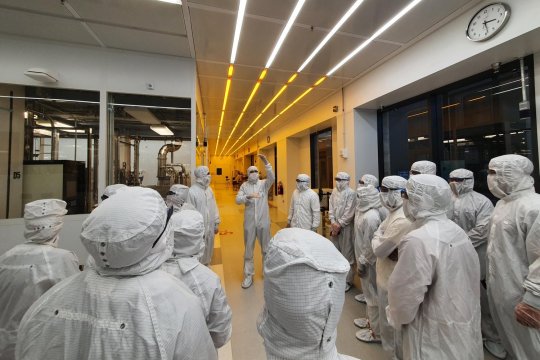

VIAVI Solutions, a global provider of communications test and measurement and optical technologies, has joined the MIT.nano Consortium.
With roots going back to 1923 as Wandell and Goltermann and to 1948 as Optical Coating Laboratory Inc., VIAVI is a global enterprise supporting innovation in communication networks, hyperscale and enterprise data centers, consumer electronics, automotive sensing, mission-critical avionics, aerospace, and anti-counterfeiting technologies.
“VIAVI is an exciting new member of the MIT.nano Consortium. The company’s innovations overlap with MIT’s research interests in a variety of applications — electronics, 3D sensing, optics, data analysis, artificial intelligence, and more,” says Vladimir Bulović, the founding faculty director of MIT.nano and the Fariborz Maseeh (1990) Professor of Emerging Technologies. “VIAVI’s awareness of industry needs will make them a valuable collaborator as we at MIT.nano work to develop new technologies in the lab that can successfully transition to the real world.”
With over 3,600 employees in 22 countries, VIAVI is poised to contribute global insights to the MIT.nano Consortium and MIT research community.
“VIAVI is delighted to be part of the extraordinary MIT.nano ecosystem,” says Oleg Khaykin, president and CEO of VIAVI. “MIT.nano occupies a unique position at the intersection of academia, industry, and government. We look forward to collaborating with the organization and its stakeholders focused on innovation in materials and processes that will enable the photonics applications of the future.”
The MIT.nano Consortium is a platform for academia-industry collaboration centered around research and innovation emerging from nanoscale science and engineering at MIT. Through activities that include quarterly industry consortium meetings, VIAVI will gain insight into the work of MIT.nano’s community of users and provide advice to help guide and advance nanoscale innovations at MIT alongside the 11 other consortium companies:
Analog Devices
Edwards
Fujikura
IBM Research
Lam Research
Lockheed Martin
NC
NEC
Raith
Shell
UpNano
MIT.nano continues to welcome new companies as sustaining members. For more details, visit the MIT.nano Consortium page.
#3d#Advice#aerospace#analog#Analysis#applications#artificial#Artificial Intelligence#automotive#awareness#CEO#Collaboration#communication#communications#Community#Companies#consumer electronics#data#data analysis#Data Centers#details#devices#Electronics#emerging technologies#employees#engineering#enterprise#enterprise data centers#Faculty#Future
0 notes
Text
NASA Announces Semifinalists of Power to Explore Challenge - NASA
New Post has been published on https://sunalei.org/news/nasa-announces-semifinalists-of-power-to-explore-challenge-nasa/
NASA Announces Semifinalists of Power to Explore Challenge - NASA
NASA selected 45 student essays as semifinalists of its 2024 Power to Explore Challenge, a national competition for K-12 students featuring the enabling power of radioisotopes.
NASA selected 45 student essays as semifinalists of its 2024 Power to Explore Challenge, a national competition for K-12 students featuring the enabling power of radioisotopes. Contestants were challenged to explore how NASA has powered some of its most famous science missions and to dream up how their personal “superpower” would energize their success on their own radioisotope-powered science mission. The competition asked students to learn about Radioisotope Power Systems (RPS), “nuclear batteries” that NASA uses to explore the harshest, darkest, and dustiest parts of our solar system. RPS have enabled many spacecraft to conduct otherwise impossible missions in total darkness.
In 250 words or less, students wrote about a mission of their own that would use these space power systems and described their own power to achieve their mission goals. The challenges of space exploration without solar power are especially relevant ahead of the United States’ upcoming April 8 total solar eclipse, which will offer a momentary glimpse into what life would be like without sunlight.
Carl Sandifer
Program Manager, Radioisotope Power Systems Program.
The Power to Explore Challenge offered students the opportunity to learn more about these reliable power systems, celebrate their own strengths, and interact with NASA’s diverse workforce. This year’s contest received 1,787 submitted entries from 48 states and Puerto Rico.
“It has been so exciting to see how many students across the nation have submitted essays to NASA’s Power to Explore Challenge,” said Carl Sandifer, program manager of the Radioisotope Power Systems Program at NASA’s Glenn Research Center in Cleveland. “We have been thrilled to read their creative RPS-powered mission concepts and have been inspired learning about their many ‘superpowers’ that make them the bright future of NASA – the Artemis Generation.”
Entries were split into three categories: grades K-4, 5-8, and 9-12. Every student who submitted an entry received a digital certificate, and over 4,094 participants who signed up received an invitation to the Power Up virtual event. With NASA’s Associate Administrator for the Science Mission Directorate Nicola Fox, NASA’s Radioisotope Power Systems Program Manager Carl Sandifer, and Kim Rink of NASA’s Jet Propulsion Laboratory in
Southern California, students learned about what powers the NASA workforce to dream big and work together to explore.
Fifteen national semifinalists in each grade category (45 semifinalists total) have been selected. These participants also will receive a NASA RPS prize pack. Finalists for this challenge will be announced on April 8 in celebration of the total solar eclipse.
Maryam Asif, Sarasota, FL
Thashvi Balaji, Riverview, FL
Yavuz Bastug, Peckville, PA
Claire Bennett, La Grange, NC
Ada Brolan, Somerville, MA
Joseph Brown, Huntsville, AL
Ashwin Cohen, Washington, D.C.
Adara George, Lithia, FL
Katerine Leon, Long Beach, CA
Rainie Lin, Lexington, KY
Connor Personette, Lakeland, FL
Yash Rajan, Issaquah, WA
Camila Rymzo, Belmont, MA
Arslan Soner, Columbia, SC
Zachary Tolchin, Guilford, CT
Nithilam Arivuchelvan, Short Hills, NJ
Nandini Bandyopadhyay, Short Hills, NJ
Cooper Basi, Rocklin, CA
Joshua Cheng, Rockville, MD
Kaitlyn Chu, Mercer Island, WA
Mayson Howell, Troy, MO
Dhiraj Javvadi, Louisville, KY
Aadya Karthik, Redmond, WA
Subham Maiti, Bloomington, MN
Meadow McCarthy, Corvallis, OR
Elianna Muthersbaugh, Bluffton, SC
Archer Prentice, Koloa, HI
Andrew Tavares, Bridgewater, MA
Sara Wang, Henderson, NV
Anna Yang, Austin, TX
Sabrina Affany, Fresno, CA
Alejandro Aguirre, Mission Viejo, CA
Sai Meghana Chakka, Charlotte, NC
Khushi Jain, San Jose, CA
Aiden Johnson, Virginia Beach, VA
Robert Kreidler, Cincinnati, OH
Zoie Lawson, Tigard, OR
Thomas Liu, Ridgewood, NJ
Madeline Male, Fairway, KS
Dang Khoi Pham, Westminster, CA
Sofia Anna Reed-Gomes, Coral Gables, FL
Ava Schmidt, Leavenworth, WA
Madden Smith, Loveland, OH
Kailey Thomas, Las Vegas, NV
Warren Volles, Lyme, CT
The challenge is funded by the Radioisotope Power Systems Program Office in NASA’s Science Mission Directorate and administered by Future Engineers under the NASA Open Innovation Services 2 contract. This contract is managed by the NASA Tournament Lab, a part of the Prizes, Challenges, and Crowdsourcing Program in NASA’s Space Technology Mission Directorate.
Kristin Jansen
NASA’s Glenn Research Center
0 notes